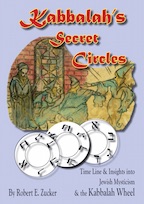Kabbalah: Kabbalah's Secret Circles Cherubim– Guardians of the Tree of Life
These pages are excerpts from the book, Kabbalah's Secret Circles, Download a free PDF sample compliments of the author. “And He placed the Cherubim to the east of the Garden of Eden and the flame of sword revolving to guard the way of the Tree of Life.” Genesis 3.24 Just before God banished Adam and Eve from the Garden of Eden, he remarked that man has “become as one of us, to know good and evil,” so he placed two cherubim at the east of the Garden with their “flame of whirling swords” to protect the “Tree of Life” in the Garden and keep out Adam and Eve out of the Garden after they were expelled. The word is Assyrian or Akkadian in origin. In Assyrian art, karubu (“interceding deities”) were depicted as huge, winged creatures with human faces and bodies of bulls or sphinxes. They were often placed at the entrance to palaces, temples as guardian spirits. 8th century BCE Phoenician art depicts winged-like creatures carrying godlike figures across the sky. They are usually depicted a human adult or child features with huge wings. Cherubim (cherub, also kerubim) are the first heavenly beings named in the OLD TESTAMENT who belong to the Order of Celestial Beings. They were not actually classified as angles and their full role in Judaic culture has never been fully revealed. In God’s instructions on how to make the Ark, he describes how to make two cherub of gold, one for each end of the Ark, and have them face each other. God is also described as riding a cherub in Psalms 18:11 and 2 Samuel 22:11. In the 13th century BCE, during the Exodus, the Cherubim were the only supernatural beings represented on the desert Tabernacle and the Jerusalem Temple where they were portrayed in a more decorative, architectural fashion than religious. In the Babylonian TALMUD, the K’rub are called rabia and described as being “childlike” and appeared youthful. They surrounded the Ark of the Covenant as winged guardians. The most famous description is given by two major figures in the OLD TESTAMENT– Ezekiel and Enoch. When the Ezekiel preached to the Jewish captives of Babylon in 6 BCE, he gave an eye-witness account of the cherubim– the Holy Beasts. The prophet described in his BOOK OF EZEKIEL that these unearthly beings looked like four living creatures each with four faces— lion, ox, eagle, and man— having the figure and hands of a man, and the feet of calves and four wings. He also described their chariot and the four wheels, called the Wheelwork, that spun next to the cherubim– as if they were a “wheel within a wheel.” Enoch gave an eye witness account of his vision of the Cherubim in 1 BCE. He wrote that after awakening, he saw the appearance of two men, or angels, who guided him through the various levels of Heaven. “Behold,” Enoch wrote, “I saw a very great light, and all of the fiery hosts of archangels, and the incorporeal powers and the lordship, and the principalities, and of the dominions: Cherubim and Seraphim, thrones and the watchfulness of the Ofanim (“many eyes”). Their images were prominently displayed in the Temple until the end of the 2nd Jewish Commonwealth in 70 CE when Jerusalem was seized and looted. Rabbi Pinhas ben Yahir, a 2nd century CE Palestinian teacher remarked that the two cherubim over the Ark of the Covenant corresponded to the two Holy Names of Yahweh (“Lord”) and Elohim (“God”). After the 5th century, cherubim earned angelic status when ranked among the First Order of Angles by the Greeks. Milton often drew on the images mentioned in Ezekiel’s vision of the Cherubim. Cherubim also played a role in sleep as the body transitions through several stages, according to an ancient Midrash. These angels never sleep, but always watch the throne of God. Continue reading:
These pages are excerpts from the book, Kabbalah's Secret Circles, Download a free PDF sample compliments of the author.
Kabbalah's Secret CircleKabbalahEntertainment Magazine© 2016-2017 Copyright by Robert Zucker. Entertainment Magazine.EMOL.org.
|